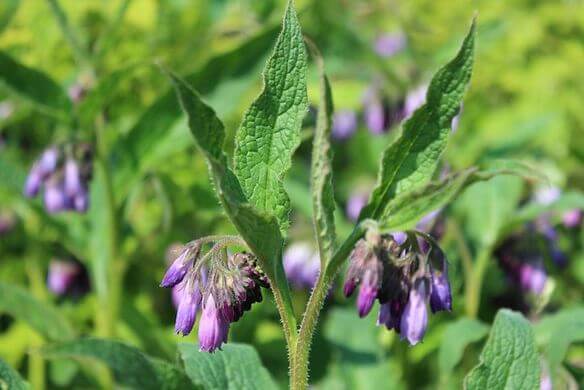With high nutrition contents, the common comfrey (Symphytum officinale) is very popular among herbalists. This herb has exceptional medicinal properties. There’s a catch, though. This herb is slightly toxic. But its health benefits greatly outweigh its drawbacks. This plant is part of the borage family and it’s native to Europe. Comfrey grows in other places like North America, but it’s often regarded as a weed or an invasive species.

(Photo by: Trish Steel/Wikimedia Commons)
Edibility and culinary uses
Comfrey has a pleasant but mild cucumber-like taste, much like borage. Young comfrey leaves are quite good to eat. They’re slightly hairy and have a mucilaginous texture. Older leaves are covered with a lot of coarse hairs and taste very bitter. These leaves can be chopped up to be added in salads. Alternatively, they can also be stir-fried like spinach, added into soups, blended with green juices, or deep fried to make fritters. Be careful not to overcook them, though. Overcooked leaves taste bitter and unpalatable.
In addition to that, young comfrey shoots can be used as a substitute for asparagus in many recipes. Meanwhile, the roots can be roasted and combined with chicory roots and dandelion to make coffee. Lastly, the leaves and roots can also be dried to make tea leaves. Comfrey herbal tea is wonderful as herbal medicine.
Health benefits
Comfrey leaves and roots contain a compound called allantoin. Allantoin has the ability to encourage skin cell growth and regenerate connective tissues. It also contains tannin and rosmarinic which also encourage skin cells growth and reparation, giving this herb amazing external healing properties. For this reason, comfrey is often applied to unbroken skin to help treat ulcers, burns, wounds, joint inflammation, bruises, sprains, gouts, and fractures.

(Photo by: Brian Pettinger/Flickr)
Aside from that, this herb is rich in protein, minerals, antioxidants, vitamin A, and vitamin B12. Despite being slightly toxic, its health benefits far outweigh its toxicity. It’s used to heal many ailments such as upset stomach, chest congestion, sore throats, diarrhea, gallstones, ulcers, pneumonia, and pleurisy.
Cultivation
Aside from being a medicinal herb, comfrey can give you other benefits as well. The bell-shaped flowers are full of nectar and pollen which can help attract bees and butterflies to your garden. This plant also grows very quickly, allowing you to use it as an ‘instant compost’ for other plants in your garden.
Comfrey is a quite hardy plant. It can thrive almost all types of soil and it’s drought-resistant. However, it will thrive best in rich soils and regular watering will help it grow stronger. This plant loves sunny locations but it grows best under the partial shade of a tree.
The seeds need a winter chilling period to germinate. Start them indoors, then once the danger of frost has passed, you can transfer them outside. Place each plant 2 ½’ away from each other to avoid overcrowding. These plants don’t need a lot of maintenance after they’ve settled down, just make sure to clear out surrounding weeds every once in a while.
Cautions

(Photo by: Jon Obsworth/Flickr)
As mentioned earlier, this plant is mildly toxic. The small quantities of alkaloids found in comfrey can have a cumulative effect on liver health if too much is consumed regularly. People with liver problems should not ingest comfrey. It’s also recommended to avoid this herb during pregnancy as it may cause birth defects. The roots have the highest concentration of alkaloids while the leaves tend to contain more alkaloid as they grow older. In contrast, young leaves contain almost no alkaloids.
Don’t apply comfrey on broken or damaged skin to avoid abscesses forming. Don’t consume this herb while taking pyrrolizidine alkaloids as this combination may result in liver diseases, liver failure, or even cancer. Overconsumption may cause vomiting, loss of appetite, and abdominal pain.
Conclusion
Comfrey has had a long history as a medicinal herb. It has been used for thousands of years across the world, from Rome to China. Despite recent reports showing that comfrey might have mild toxic effects, its medicinal benefits are still undeniably amazing. Comfrey is a very useful plant to have around, whether as a supplementary food source or as a first aid herbal remedy.
---------------
Writen by Cornelia Tjandra
Cornelia is a freelance writer with a passion for bringing words to life and sharing useful information with the world. Her educational background in natural science and social issues has given her a broad base to approach various topics with ease. Learn more about her writing services on Upwork.com or contact her directly by email at cornelia.tjandra@gmail.com
Many of our readers find that subscribing to Eat The Planet is the best way to make sure they don't miss any of our valuable information about wild edibles.
See our privacy policy for more information about ads on this site







One Response
Hello, do you sell or you know where I can get comfrey and nettle seeds or plants?